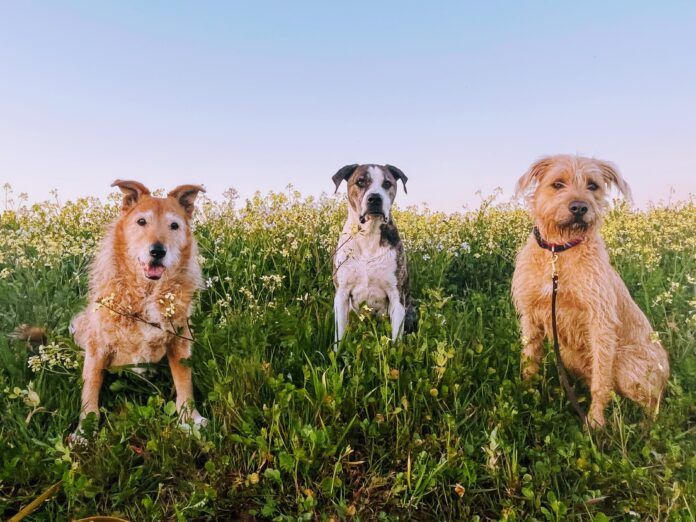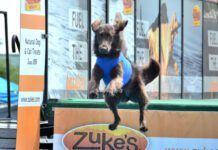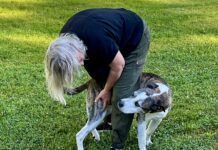
I just received the results of my youngest dog’s mixed-breed DNA test from Embark; I already had results from Wisdom Panel. Over the years, I’ve submitted DNA samples from all three of my dogs to both of the most reputable providers of mixed-breed identification tests. In my opinion, the results have gotten more accurate over time – and they even concur on much of the information returned. With one interesting exception – see if you can find it.
Otto
Embark
21.3% American Pit Bull Terrier
14.1% Australian Cattle Dog
13.2% German Shepherd Dog
12.3% Chow Chow
10.3% Labrador Retriever
8% Border Collie
4.3% Rottweiler
16.5% “Supermutt”
Wisdom Panel
12.5% American Staffordshire Terrier
12.5% Australian Cattle Dog
12.5% Border Collie
12.5% Chow Chow
12.5% German Shepherd Dog
37% Mixed Breed Groups
Woody
Embark
40.8% American Pit Bull Terrier
30.3% Labrador Retriever
19.9% American Staffordshire Terrier
9.0% Olde English Bulldogge
Wisdom Panel
62.5% American Staffordshire Terrier
25% Labrador Retriever
12.5% Mixed Breed Groups
Boone
Embark
42.0% American Pit Bull Terrier
29.1% American Staffordshire Terrier
8.1% American Bulldog
8% Boxer
4.7% English Springer Spaniel
Wisdom Panel
36% American Staffordshire Terrier
29% American Pit Bull Terrier
6% Boxer
6% German Wirehaired Pointer
5% American Bulldog
5% Springer Spaniel
4% Great Dane
3% Australian Cattle Dog
2% German Shorthaired Pointer
2% Labrador Retriever
2% Chow Chow
Embark thinks that ALL of my dogs have more American Pit Bull Terrier in them than anything else; Wisdom Panel thinks that all of my dogs have more American Staffordshire Terrier in them than anything.
Despite owning three of these dogs with an apparent preponderance of “bully” breeds in them, I don’t know how American Pit Bull Terriers and American Staffordshire Terriers can be so interchangeable. Who can explain this, in simple terms? I’ve read a dozen articles and am still mystified. At least the companies are consistent in their results!






I have been working with dogs since 1970 in various positions as Kennel manager, APDT trainer, purebred dog breeder. In all that time working in California I have never seen a chow wandering the street.
What I find interesting is none of the breed’s listed for Otto show his wire haired coat pattern.
My AKC registered American Staffordshire is also UKC registered as an American Pit Bull Terrier but the one time I showed him at a UKC show going Reserve Best in Show the other exhibitors were unhappy that I was showing him.
Fascinating topic, Nancy, and on my mind recently too! We’ve only submitted to Embark for our rescue pup, Kāli, who came back as 100% APBT. The one-color pie chart baffled me for a few minutes when reviewing the results! Of note though, her closest DNA “relatives” listed by Embark, as close as first cousins, all tested as 100% American Staffordshire Terrier. She’s a short little thing at 45 lbs. I’d be curious to see what Embark would say on the topic.
Danielle, I had the same experience as you. Our 48lb male bully came back 90% APBT but most of his closest relatives were American Bullys. I asked Embark if their results were in error (after all, he’s sized more for an American Bully than an APBT) and while I don’t recall it exactly, their answer was something along the lines of, these two breeds share so many common ancestors and so much mixing that it is not uncommon for a dog from one breed to have a lot of DNA in common with a dog from another. They don’t actually have to be closely related. Essentially, the pool is too small, and having the same chromosomes as another dog doesn’t mean they are actually half-siblings. I am not a scientist, I am only paraphrasing what the Embark associate told me! But that sheds a little light on Nancy’s experience too, where Embark and Wisdom possibly attributed the same chromosomes to different bully breeds. Nancy, I hope you do ask them yourself and let us know what they say!
I can’t explain these results BUT, Embark is great to answer your questions! Check with the company and I am sure that a specialist will get in touch with you. I hope that you post the information when you get an answer.
Several years ago I sent samples for my dogs to Wisdom and one of the results for a dog originally rescued from a Caribbean island was clearly wrong. I called them and they said that (at least at that time ) they could not test international dogs. I asked isn’t a golden retriever a golden retriever everywhere? And they said no. Variations in breeds occur from different parts of the world so their algorithm couldn’t account for that. Even though your dogs aren’t international maybe it’s a difference in the particular algorithms used that account for the different results. ( btw Wisdom graciously refunded my money)
I do both with my mixes too. They were close for my cattle’s dog mix, other than Staffordshire / Pit Bull at #2. So about 35% Australian Cattle Dog, 20% Pit/Staffie, 15% Australian Shepherd. Embark has 18% Mountain Cur. Wisdom says Chihuahua and more. I wonder if some of the difference there is available comparison sources West coast (Wisdom) vs. East (Embark)?
I have a dog from Lebanon who is about 50% GSD. There is a lot of “supermutt” in the mix that’s pretty hard to figure out. And I wish companies would run the results again when they update their data, but unfortunately it’s only done once. For anyone who doesn’t want the expense of a DNA test, the free phone app “What’s My Mutt?” seems to do a reasonably accurate job.
I also did both tests on my dogs.
I felt that Wisdom was more accurate in the breakdown and mix of the breeds but the one place where Embark shines is finding relatives and being able to message them. We found Diana’s brother and had a meet up at the beach for the two to play together. They clearly recognized each other. She also has a brother on Wisdom but there is no way to contact him.
Freyja is half husky but the breakdown on Wisdom was in my opinion much more accurate. I also like their grouping of the breeds into herding, guarding, etc.
I think which is more accurate depends on the last time they upgraded and refined their testing.
As for the bully breeds, I think they have been mixed back and forth a lot, making it difficult to separate the two. In my area they are also the most prevalent in shelters and the most likely to be roaming the streets breeding because they are not neutered. The only dog I have that doesn’t have a bully in the mix is Freyja. In the local shelter you will get one of four in the mix: bully, GSD, poodle or Chihuahua. They are simply the most prevalent to be out breeding. The little ones will have poodle or Chihuahua and the big ones will have GSD or bully in them. Diana is predominantly GSD, Golden Retriever and… Staffie.
Why Chow keeps coming up, I’m not sure. But it’s in Diana’s and Dolly’s Embark results.
In answer to Nancy’s question, my understanding is that the breeds are interchangeable. This understanding is reinforced by the the fact that The American Staffordshire Terrier, also known as the AmStaff is recognized by the American Kennel Club, but not the United Kennel Club, which instead allows American Staffordshire Terriers to be registered under the American Pit Bull Terrier breed. Also to the point of being interchangeable, during the time that I worked in adoptions at my local shelter (in Wisconsin) a number of years ago, we would often refrain from using the Pit Bull description to assist adopters in retaining home owners insurance. By designating the dog as an American Staffordshire Terrier, the adopter would often be able to avoid being dropped from insurance for having a Pit Bull.
Thank you! This explains some of the discrepancy. When two different Kennel Clubs register the “pure breed” dogs with separate classifications, that terminology would naturally show up in the testing classification.
It’s fascinating. Wisdom Panel was the cutting edge when we wanted to find out the mix of our specially blended dogs. And it was helpful for our GSD/cattle dog/husky mix because collie appeared in her make-up, which explained why she was sooooo talkative. Absolutely nothing about her physically would have made one think she was part collie.
Our rescue boy was interesting in that his initial panel came back lab/GSD with just about every northern breed in the great or great-grandparent level. He was cream colored and the lab people would see the GSD in him and the GSD people would see the lab in him. When Wisdom Panel added more breeds, we retested him (and did not tell Wisdom Panel it was a retest). The second panel came back labrador retriever and golden retriever 50/50. Baloney–we were and are still convinced to this day that he was a Chinook. The testing just wasn’t refined enough at the time.
If the tests had been available, I would have done all three for my dogs–just because I am that kind of science geek.
Interesting. I was expecting the opposite – Embark to say AmStaff and Wisdom to say APBT – based on my bully being identified as AmStaff by Embark. Maybe I’ll try the Wisdom breed analysis. I don’t know if it’s relevant but I had the test done 2 or 3 years ago.
I don’t understand if there is any genetic or appearance difference between the two breeds. Anyone? I have heard about using AmStaff to get around insurance issues with Pitties, and that one Kennel Club recognizes AmStaff while the other recognizes APBT, as other comments have noted.